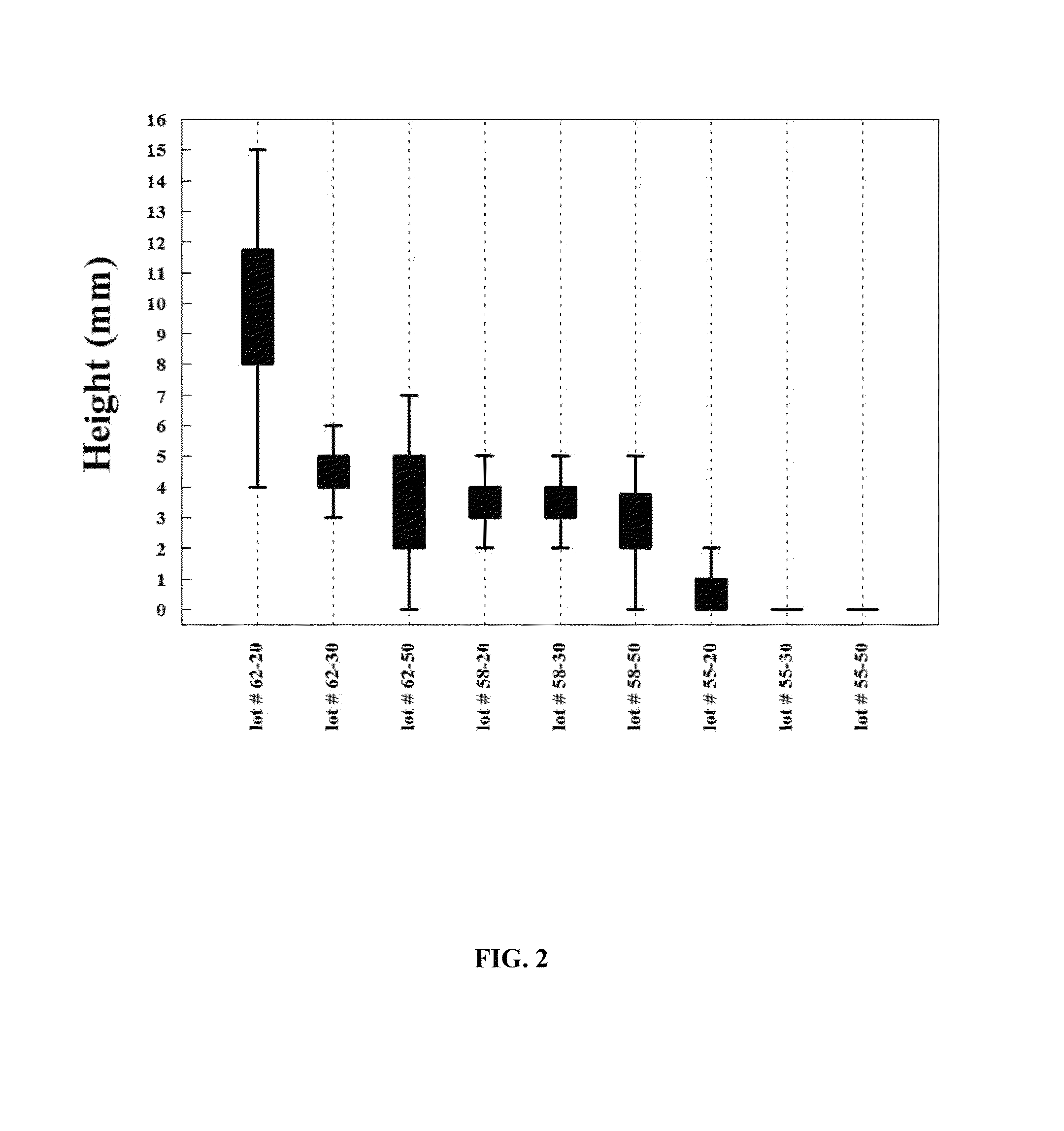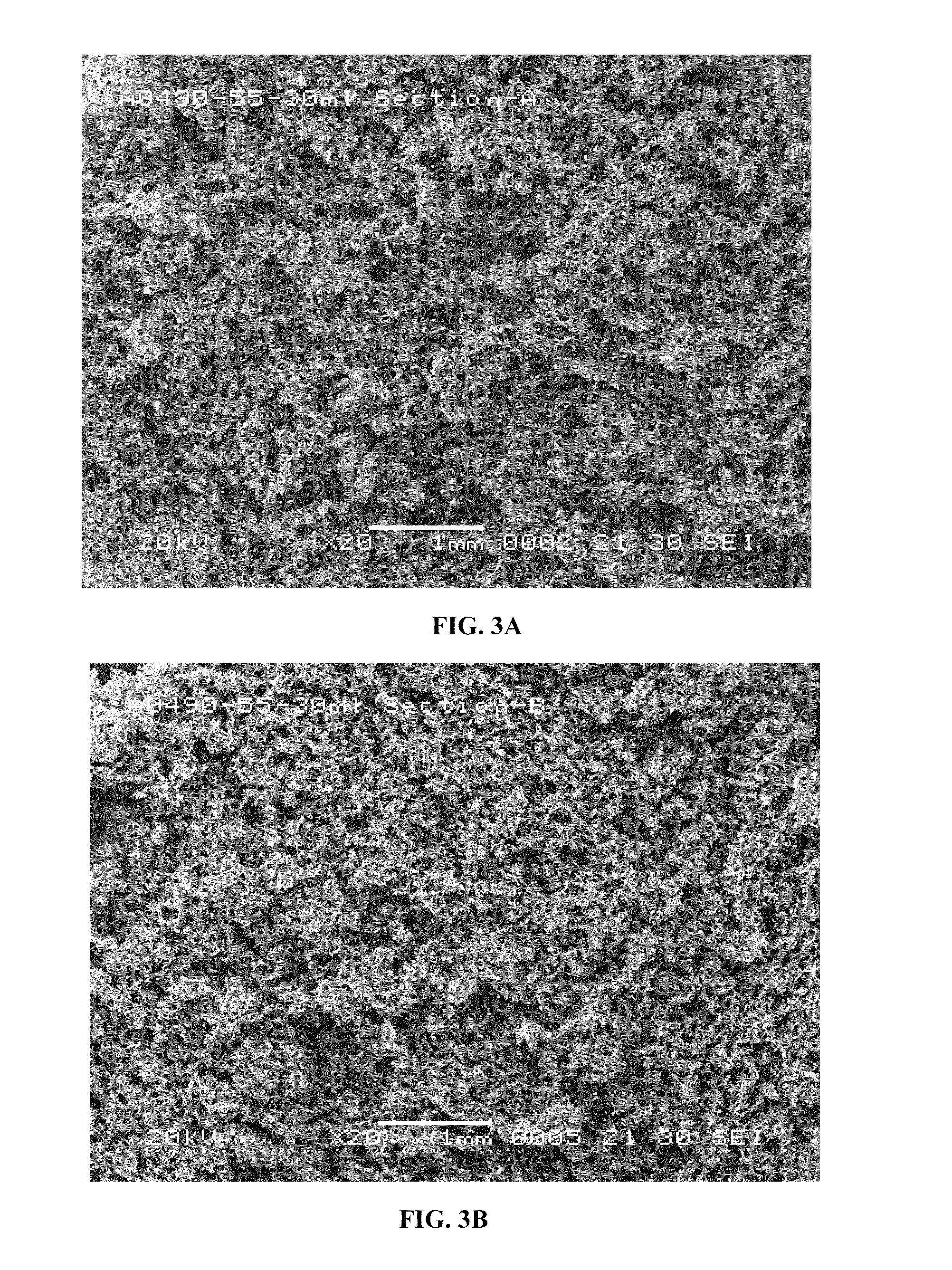Lyophilization of synthetic liposomal pulmonary surfactant
a technology of liposomal pulmonary surfactant and lyophilization, which is applied in the direction of drug compositions, peptide/protein ingredients, lighting and heating apparatus, etc., can solve the problems of limiting the batch size, and reducing the batch size, so as to reduce or eliminate the cake levitation, reduce or eliminate the effect of levitation
- Summary
- Abstract
- Description
- Claims
- Application Information
AI Technical Summary
Benefits of technology
Problems solved by technology
Method used
Image
Examples
example 1
[0084]Lyophilization was performed using the novel process and previously published processes described in U.S. Pat. Nos. 5,952,303 and 7,582,312 to demonstrate the differences imparted by each process on the resulting lyophilized product.
Materials: the ingredients in the formulations lyophilized by each of the three processes are summarized below in Table 1. Actual amounts are adjusted for purity of raw materials.
[0085]
TABLE 1Raw Materials for Formulations I, II, and III (3000 g Batch Size)Amount (mg) perAmount (g) perMaterialsgram of formulationbatchKL4 (API) 0.74 mg 2.22 gDPPC (API)18.00 mg54.00 gPOPG, Na (API) 5.82 mg17.47 gPA (API)3.113 mg 9.38 g95% Ethanol0.105 mg 316 gTRIS Buffer:NaCl 5.83 mg17.49 gTromethamine 1.86 mg 5.57 gWater0.859 g 2578 g
Procedure: two 3000 gram batches were prepared for each of the three processes. A syringe was used to charge to the standard fill weight of 13.7 grams per vial. Preparation of a pre-lyophilization mixture: the APIs were dissolved in 9...
example 2
[0086]Formulation I. The pre-lyophilization mixture from Table 1 was used as a fill in 20, 30 and 50 mL glass vials and lyophilized using the novel lyophilization method described above. Table 2 summarizes parameters of the lyophilization process.
[0087]
TABLE 2Parameters for the Novel Lyophilization ProcessPhases ofLyophilizedCycleStepsParametersBeginningInitial Shelf 5° C. hold for 2 hoursPhase*Temperature:FreezingCooling Step−20° C. at 1.0° C. / minPhase*Cooling Step−30° C. at 0.5° C. / minCooling Step−40° C. at 0.25° C. / minCooling Step−50° C. at 0.10° C. / minHold Step−50° C. for 4 hoursAnnealingHeating Step−22° C. at 0.5° C. / minPhase*Annealing Step−22° C. for 4 hoursCooling Step−30° C. at 0.5° C. / minCooling Step−40° C. at 0.25° C. / minCooling Step−50° C. at 0.10° C. / minHold Step−50° C. for 4 hoursPrimary DryingVacuum:40 mTPhase**Hold Step−50° C. for 1 hourHeating Step−25° C. at 0.10° C. / minHold Step−25° C. for 100 hoursSecondaryHeating Step 25° C. at 0.5° C. / minDryingPhase**Hold Step 25...
example 3
[0088]Formulation II. The pre-lyophilization mixture from Table 1 was used as a fill in 20, 30 and 50 mL glass vials and lyophilized using the process described in U.S. Pat. No. 5,952,303 to Bornstein (“Bornstein Lyo Cycle”). Table 3 summarizes parameters of the process.
[0089]
TABLE 3Lyophilization Parameters for Bornstein Lyo CycleInitial Shelf Temperature*: 25° C.Cooling Step*−40° C. at 1.0° C. / minHold Step*−40° C. for 2 hoursVacuum:100 mTHeating Step** 0° C. at 0.5° C. / minHold Step** 0° C. for 48 hoursHeating Step** 26° C. at 0.5° C. / minHold Step** 26° C. for 12 hoursBackflush**:N2 to ½ bar prior to sealing vials*The phase is conducted at the atmospheric pressure.**The phase is conducted under vacuum.
PUM
| Property | Measurement | Unit |
|---|---|---|
| specific surface area | aaaaa | aaaaa |
| temperature | aaaaa | aaaaa |
| temperature | aaaaa | aaaaa |
Abstract
Description
Claims
Application Information
 Login to View More
Login to View More - R&D
- Intellectual Property
- Life Sciences
- Materials
- Tech Scout
- Unparalleled Data Quality
- Higher Quality Content
- 60% Fewer Hallucinations
Browse by: Latest US Patents, China's latest patents, Technical Efficacy Thesaurus, Application Domain, Technology Topic, Popular Technical Reports.
© 2025 PatSnap. All rights reserved.Legal|Privacy policy|Modern Slavery Act Transparency Statement|Sitemap|About US| Contact US: help@patsnap.com



